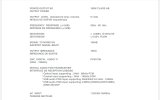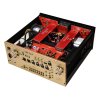OK. So a hybrid amp with a couple of tubes in the preamp section doing... something. There's an inbuilt DAC that will probably be perfectly adequate. There's a power amp in section for when you come to your senses. I'm not surprised you chose that over the other two amps auditioned, which both have serious measurable issues. You are choosing a cleaner amp than the others you auditioned... and based purely on what "the science" says, you should go a
lot further down that road...
seriously, consider the Lyngdorf!
I can find no measurements for this Advance Paris product. We have no idea what this amp is really doing. There's no damping factor or equivalent spec to tell if it will be affected by speaker impedance.
There are no independent measurements that I can find. Still, it should drive your choice of speakers. There's a USB input if you want to use a computer or a streamer without using its DAC. There are power amp inputs, so you could try a DAC/preamp at some point in the future when you realise the tubes aren't really such a good idea.
So nothing too bad necessarily, but an unknown quantity.
https://www.advanceparis.com/en/product/a12-classic/ for anyone who wants to look
The speakers appear to be a good choice, good measurements according to threads here and the amp will drive them. Simply, with good speakers and a reasonably damped room, you are 90% of the way there, regardless of a couple of tubes in the pre or some/no room correction. So make sure that you at least have a thick rug on the floor, and that the speakers are optimally placed (so you may need a little more than that two feet away from the wall, rather than less). You get more bass closer to the wall, but unless the rear port is well controlled and the speaker is designed to be close to the wall, you will end up with a less detailed sound into the bargain, and maybe a few other surprises.
Follow the advice in the user guide.
The streamer or PC are as much about ergonomics as anything else. You mentioned a computer: I might suggest a reasonable fanless PC with Roon, and measure with REW to get a useable EQ to add. Plenty can advise you here on that. Roon isn't cheap, but still cheaper than a DMP10, so you have budget for it. If you want automatic room correction, there are PC apps you can get for that.
Just use the built in DAC for now.
The tubes are probably adding some THD rather than messing with the FR a lot, so any "sound" will come through with the EQ/DSP/room correction, but honestly and repeating the point, I think you would still prefer a more accurate amp in practice. Still, I think you'll be good enough in practice based on what you've said, though you could be better.
And please, forget the DAC chip BS, that's about engineering, not the chip chosen.


